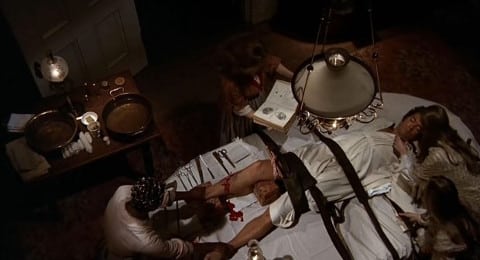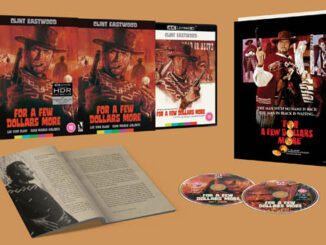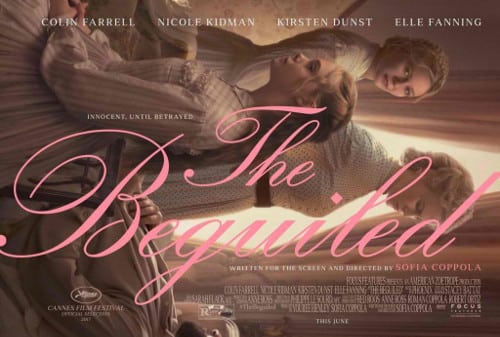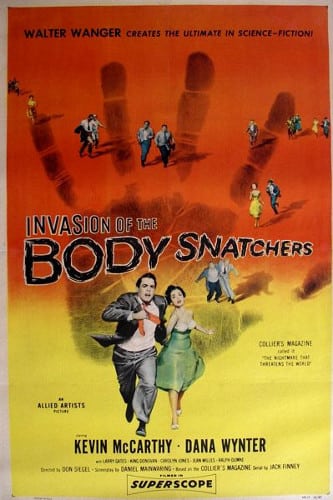The Beguiled (1971)
Directed by: Don Siegel
Written by: Albert Maltz, Irene Kamp, Thomas Cullinan
Starring: Clint Eastwood, Elizabeth Hartman, Geraldine Page, Jo Ann Harris
USA
AVAILABLE ON BLU-RAY AND DVD
RUNNING TME: 105 mins
REVIEWED BY: Dr Lenera, Official HCF Critic
SOME SPOILERS!
During the middle of the American Civil War in 1863, injured Union soldier John McBurney is rescued from the verge of death by 12-year-old Amy, a student at an all-girl boarding school in rural Mississippi, the Miss Martha Farnsworth Seminary for Young Ladies. Martha reluctantly agrees to take him in until he has built his health, under the condition that he is locked in the music room and kept under watch. Edwina, the schoolteacher, takes an immediate liking to John, as does Carol, a teenage student. John begins to bond with each of the women in the house, including the slave Hallie, but, as he charms each of the women, the sexually repressed atmosphere of the school becomes filled with jealousy and deceit….
I’ve actually wanted to review The Beguiled for some time, seeing as it’s probably the oddest film to star a certain actor whom I’ve loved since I was about ten [and too young to watch many of his movies, not that it’s turned me into a psychopath – I don’t think], but of course it’s the fact that a remake is now in cinemas that has finally prompted me to do so. Much like many viewers in 1971, a year which was an important one for Clint as he also had his first outing as Dirty Harry who soon became as iconic as The Man with No Name, and directed his first film Play Misty For Me, I didn’t quite know how to take The Beguiled when I first saw it, and yet it stayed in my mind and now I’m convinced it just about belongs in his top twenty pictures [he’s made so many good ones]. It’s a troubling and provocative slice of Southern Gothic with a highly claustrophobic atmosphere that even right from the start feels like it’s about to boil over. It’s been called misogynist, and director Don Siegel didn’t help matters by saying that it’s about “the basic desire of women to emasculate men”, though I personally think that if you want to accuse the film of something than misanthropy might be closer to the mark. After all, Eastwood’s character is hardly a sympathetic one, and I doubt many viewers even back in 1971 didn’t feel that at least partly he deserves his sorry fate. I think that the ambiguity of some of the motivations and indeed the characters, and the fact that nobody is 100% “nice” [not even a 12 year old girl] are what makes it hard to enjoy for many – but watching with a critical eye reveals much to admire.
Eastwood read the entire 1966 novel by Thomas P. Cullinan, which was origianally entitled A Painted Devil, during one night, and was to keen to star in a film of it where he could do something different to what he usually did onscreen. The initial screenplay was by Albert Maltz, though he changed the book’s ending to a much happier one. Claude Traverse was brought in to rewrite the finale and a few other bits, though various disagreements led to Traverse not being credited, Maltz credited under a pseudonym, and another writer Irene Camp doing some extra work on the script. Siegel, directing Eastwood for the third time, wanted Jeanne Moreau for the role of Martha, and I thinks she would have been magnificent, but Universal overruled him. The studio didn’t get their way elsewhere though. They kept insisting that the ending be changed back to a happy one, and wanted all of filming to take place in a studio, but much of the film was shot at the Ashland-Belle Helene Plantation, a historic house which used to be a plantation estate, and Ascension Parish, both in Louisiana. Siegel forbade the use of makeup by the actresses though they sometimes wore some anyway. Not helped by a misleading poster which featured Eastwood with a gun [he only shoots someone in a flashback], the film flopped and Eastwood was so unhappy with the way Universal botched its release that once his long term contract with them was over in 1975, he left them and didn’t work again with Universal until 2008. In the UK the leg amputation lost some shots due to the usual BBFC nannying. Sixteen years later, co-stars Eliabeth Hartman and Geraldien Page died within three days of each other, the former throwing herself out of her high aprtment window and the latter suffering a fatal heart attack.
American Civil War stills appear behind the titles and towards the end Eastwood half-sings a strange song which was obviously considered enough to warn viewers that this film isn’t typical Clint fare. The sepia becomes ‘normal’ colours as a lengthy high angle shot slowly moves down to reveal a young girl in the woods looking for mushrooms. A dead body falls from a tree to startle her and us, though more interesting to little Amy is the wounded Union soldier John she comes across. There’s a great shot as they both hide from some Confederate soldiers who are reflected in John and Amy faces, Amy refusing to give him away, and then John does something which I hadn’t noticed before [maybe the shot was cut from the TV version, I’m not sure, but I certainly didn’t remember it] and which gobsmacked me – he kisses Amy [not quite 13, but in his words “old enough for a kiss”] on the lips. Of course this was the 1970’s and there wouldn’t have been the huge fuss made about this that would have ensured if the film were made now [I’m damn sure that the remake won’t feature it], but it was still very brave of Eastwood, already a huge action star, to do it. It casts an unpleasant shadow over the rest of the film, but that’s also clearly what was intended as Amy becomes the first character to fall for John, and John, as soon as he starts to feel a bit better, begins to sweet-talk headmistress Martha, schoolteacher Edwina, teenage student Carol, and African-American slave Hallie. Even these scenes are interesting to watch. John is a little slimy, Eastwood [he really is superb in this film and his performance in it has never really got its due] ever-so-slightly varying his voice, but you can see how he appeals to all of these females, and wouldn’t some male viewers in his shoes at least consider trying to do the same?
The only one of the women who literally throws herself at John is the precocious, even slutty, Amy, perhaps the least developed of the five main female characters in the film [there are two others, but they exist very much in the background], and the most one obviously written from a male point of view. She’s perhaps the most devious too, tying a blue rag to the school’s entrance gate to alert any passing Confederate soldiers that a Yankee soldier is nearby. I don’t think that she really falls in love with John, just wants to have sex with him, but Edwina definitely does, despite, after catching John in bed with Carol, beating him with a candlestick so he falls downstairs and breaks his leg. A virgin, she has a poor image of men because her father constantly cheated on her mother and John taps into her repressed romantic fantasies with his well chosen words. Martha is the most tortured, with quick flashbacks revealing an incestuous past and one inexplicit but still quite daring dream sequence indicating that she not only desires John but also has lesbian feelings. Perhaps the character is sexually dysfunctional in an exploitative way that seems a little crude today, but she’s written sympathetically and Page makes her believable. Hallie interestingly never seems to show an interest in John, though she also has a past which ends up informing the present in a revelatory flashback near the end. There’s a scene which some today would no doubt find offensive where Abigail, one of the girls we hardly hear from, refusing to work in the fields because it’s “nigger’s work”. No doubt if the scene was shot today Abigail would have to be shown to be villainous and get some kind of comeuppance – but that’s unrealistic if you realise how so many people were back then.
It’s all very uncomfortable, yet rather believable. There’s something a little bit funny about the whole enterprise, and you have to chuckle a bit at the punishments John gets for his behaviour, yet it’s easy to see why John does [or rather tries to do – he only actually has sex with one of the women and even that is interrupted] what he does, while you do feel his agony, in another moment so convincingly performed by Eastwod, when his leg is amputated. Even though the camera cuts away from most of the gore in the manner of a Hammer Frankenstein movie, this is still a very grim scene – though the most upsetting moment for many will probably be one involving an animal [though not a typical one seen in films] which then sets up the final act. The shock, sadness and hatred on the face of actress Pamelyn Ferdyn’s [who almost played Linda Blair’s role in The Exorcist and judging by her performance here would have been bettter but that’s another story] face is a really powerful and distressing moment and something you won’t forget in a hurry – and yet Amy may very well commit the most drastic and evil act in the whole film, a film where five of the six main characters all do nasty things, and mostly [if not entirely] intentionally, though this is also one of those movies which three people could watch together and each adopt a different character’s point of view, or at least be far more sympathetic to one particular character than any of the others.
Siegel directs with more overt artistry than normal, with lots of swooping camera movements from cinematographer Bruce Surtees. Only occasionally does the overall approach to the story, which could have been told more conventionally, not quite work, such as with some voiceovers which come across as an awkward device. And there’s one important scene, when John receives a visit from Edwina who has been hostile to him, where we suddenly cut to the next scene where they tell everyone else that they’re getting married. I think we should have seen the two make up rather than it being left to our imagination. Lalo Schifrin’s main theme deliberately sounds a little “off”, with odd note progressions and chords plus an ever so slight comic element. Siegel said the The Beguiled was his own favourite of all the films he made. I don’t think it’s ever a film I will totally warm to, but it’s still a fascinating and mesmerising picture in which one notices more things with each viewing.
Review of The Beguiled 2017 coming soon!










Be the first to comment